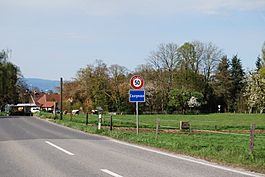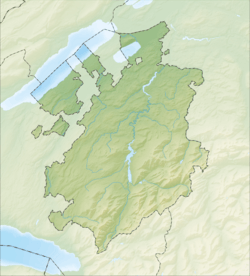Courgevaux facts for kids
Quick facts for kids
Courgevaux
|
||
|---|---|---|
 |
||
|
||
| Country | Switzerland | |
| Canton | Fribourg | |
| District | See or du Lac | |
| Area | ||
| • Total | 3.38 km2 (1.31 sq mi) | |
| Elevation | 475 m (1,558 ft) | |
| Population
(Dec 2020 )
|
||
| • Total | 1,438 | |
| • Density | 425.4/km2 (1,101.9/sq mi) | |
| Postal code |
1796
|
|
| Surrounded by | Clavaleyres (BE), Courlevon, Faoug (VD), Greng, Münchenwiler (BE), Murten/Morat, Villarepos | |
Courgevaux is a charming town, also known as a municipality, located in Switzerland. It's nestled in the canton of Fribourg, specifically within the See or Lac district. This area is known for its beautiful landscapes and a mix of cultures. Courgevaux is a great example of a typical Swiss town, blending history with modern life.
Contents
A Look at Courgevaux's Past
Courgevaux has a long history! The town was first mentioned way back in the year 1055. Back then, it was known by a slightly different name: Corgivul. This shows how old and established the community is.
Understanding Courgevaux's Land
Courgevaux covers an area of about 3.4 square kilometers (which is about 1.3 square miles). A big part of this land, almost 60%, is used for farming. This means there are lots of fields and pastures.
About a quarter of the town's land is covered by forests. This provides green spaces and natural beauty. The rest of the land, about 16%, is where buildings, roads, and other developed areas are found. A tiny bit, less than 1%, is made up of rivers or lakes.
The town is located on the main road that connects Murten (also known as Murten/Morat) and Fribourg.
Courgevaux's Official Symbol
Every town has a special symbol called a coat of arms. Courgevaux's coat of arms is black (Sable). It features a silver (Argent) wolf standing on its hind legs (rampant). The wolf's tongue is red (Gules). This unique design helps represent the town's identity.
People and Languages in Courgevaux
Courgevaux is home to over 1,400 people. As of 2008, about 27% of the people living here were from other countries. Over the past decade, the town's population has grown quite a bit, by about 38%. Most of this growth came from people moving into the town.
The people of Courgevaux speak different languages. In 2000, a little more than half the population (about 56.5%) spoke German as their main language. French was the second most common language, spoken by about 40% of the people. A smaller group, about 4%, spoke Portuguese.
More recently, in 2024, the town's website states that about 60% of residents speak German, 30% speak French, and 10% speak other languages. This shows the town's diverse linguistic mix.
Where People Come From
In 2000, about 21.5% of the people living in Courgevaux were born right there. Another 22.3% were born in the same canton (Fribourg). About 30% were born elsewhere in Switzerland, and 22% were born outside of Switzerland. This mix of backgrounds makes Courgevaux a vibrant place.
Age Groups in Town
In 2000, children and teenagers (ages 0-19) made up about 26% of the population. Adults (ages 20-64) were the largest group, at about 62%. Seniors (over 64 years old) made up about 12% of the population.
Households and Homes
In 2000, there were 348 private homes in Courgevaux. On average, about 2.5 people lived in each home. Most of the homes (almost 90%) were lived in all year round. A small number were used only during certain seasons, and a few were empty.
How Courgevaux Makes a Living
In 2010, Courgevaux had a low unemployment rate of 3%. This means most people who wanted to work had jobs.
Types of Jobs
The town's economy is divided into three main parts:
- Primary sector: This includes jobs related to getting raw materials from nature, like farming. In 2008, about 12 people worked in this sector in Courgevaux.
- Secondary sector: This involves making things, like in factories or construction. About 264 people worked in this sector. Most of these jobs were in manufacturing (making products) and construction (building things).
- Tertiary sector: This covers jobs that provide services, like shops, offices, and healthcare. About 148 people worked in this sector. Many of these jobs were in sales, vehicle repair, and healthcare.
Commuting to Work
In 2000, many people who lived in Courgevaux traveled to other towns for work (391 people). Fewer people traveled into Courgevaux for work (264 people). This means more people leave the town for their jobs than come into it. Most people (about 66%) used a private car to get to work, while a smaller number (about 7.7%) used public transportation.
Beliefs and Religions
Based on the 2000 census, about 32.6% of the people in Courgevaux were Roman Catholic. A larger group, about 44.4%, belonged to the Swiss Reformed Church. There were also smaller numbers of people who belonged to other Christian churches, Islam, or no religion at all.
Learning and Schools
Education is important in Courgevaux. About 31.6% of the population has completed upper secondary education, which is like high school. About 9% have gone on to higher education, like university or a specialized college.
The School System
The Fribourg school system works like this:
- There's one year of optional Kindergarten.
- Then, six years of Primary school.
- After that, three years of required lower Secondary school. Students are grouped based on their abilities.
- Next, students can choose to go to a three or four-year upper Secondary school. This can be a gymnasium (which prepares you for university) or a vocational program (which teaches job skills).
- Finally, after upper Secondary, students can go to a Tertiary school (like a university) or start an apprenticeship (learning a trade on the job).
In the 2010-2011 school year, Courgevaux had 56 students in 3 classes. There was one kindergarten class and two primary classes. Students for lower secondary, upper secondary, and higher education usually attended schools in nearby towns.
See also
 In Spanish: Courgevaux para niños
In Spanish: Courgevaux para niños
Images for kids





